Organisational Behaviour Report: Analysing Sainsbury's Performance
VerifiedAdded on 2023/01/12
|11
|3276
|62
Report
AI Summary
This report provides an in-depth analysis of organisational behaviour, focusing on Sainsbury's as a case study. It examines how power, politics, and culture influence individual and team performance, offering insights into the company's operational dynamics. The report delves into the application of process and content theories of motivation, including Maslow's Hierarchy of Needs and Vroom's Expectancy Theory, to achieve organisational goals. It also describes factors that contribute to team effectiveness and ineffectiveness, referencing Tuckman's theory of team development. By applying various organisational behaviour philosophies and concepts, the report offers a comprehensive understanding of Sainsbury's approach to fostering a productive and healthy work environment, aiming to improve employee performance and achieve business objectives. The report highlights the importance of employee motivation and the impact of leadership strategies on overall organisational success.
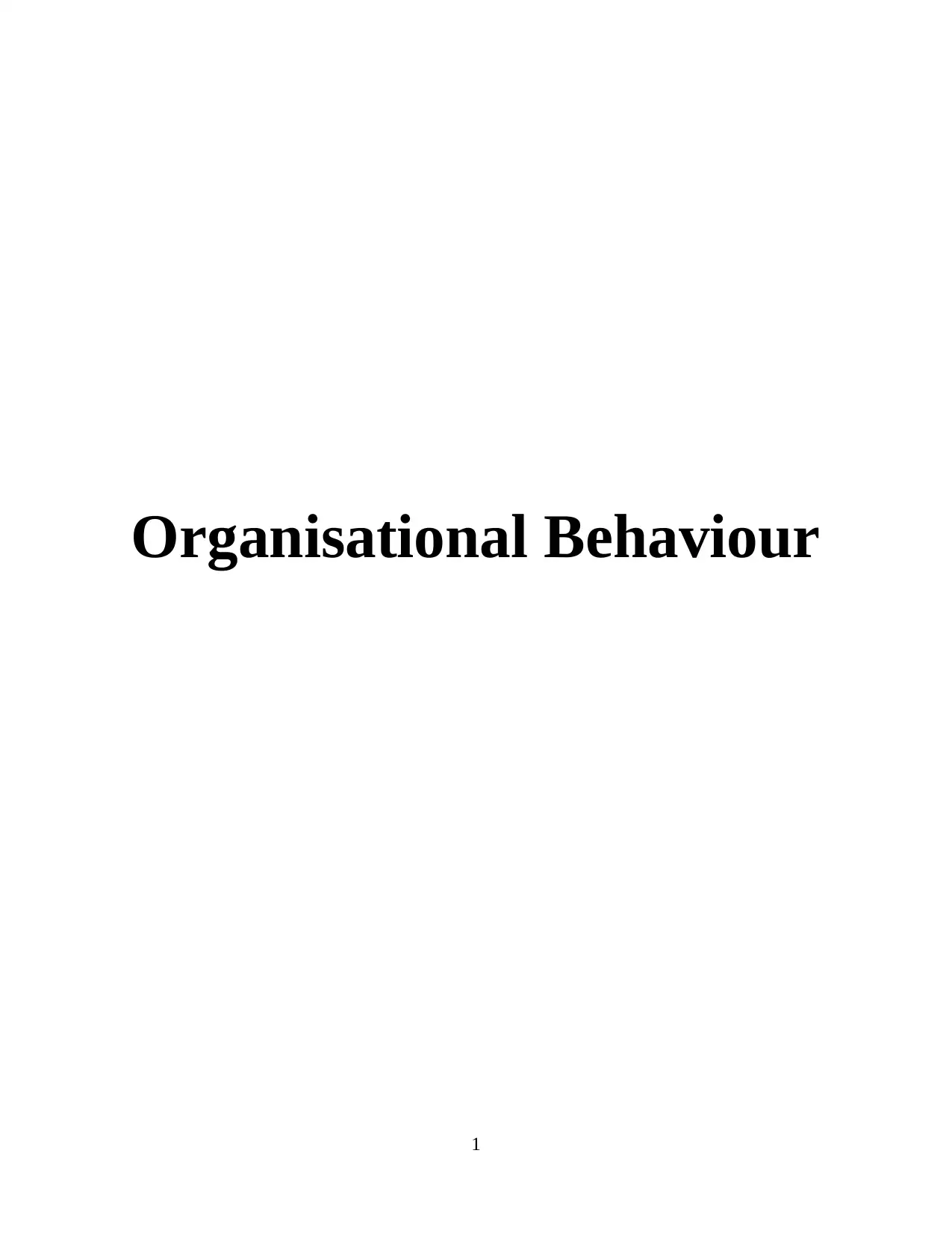
Organisational Behaviour
1
1
Paraphrase This Document
Need a fresh take? Get an instant paraphrase of this document with our AI Paraphraser
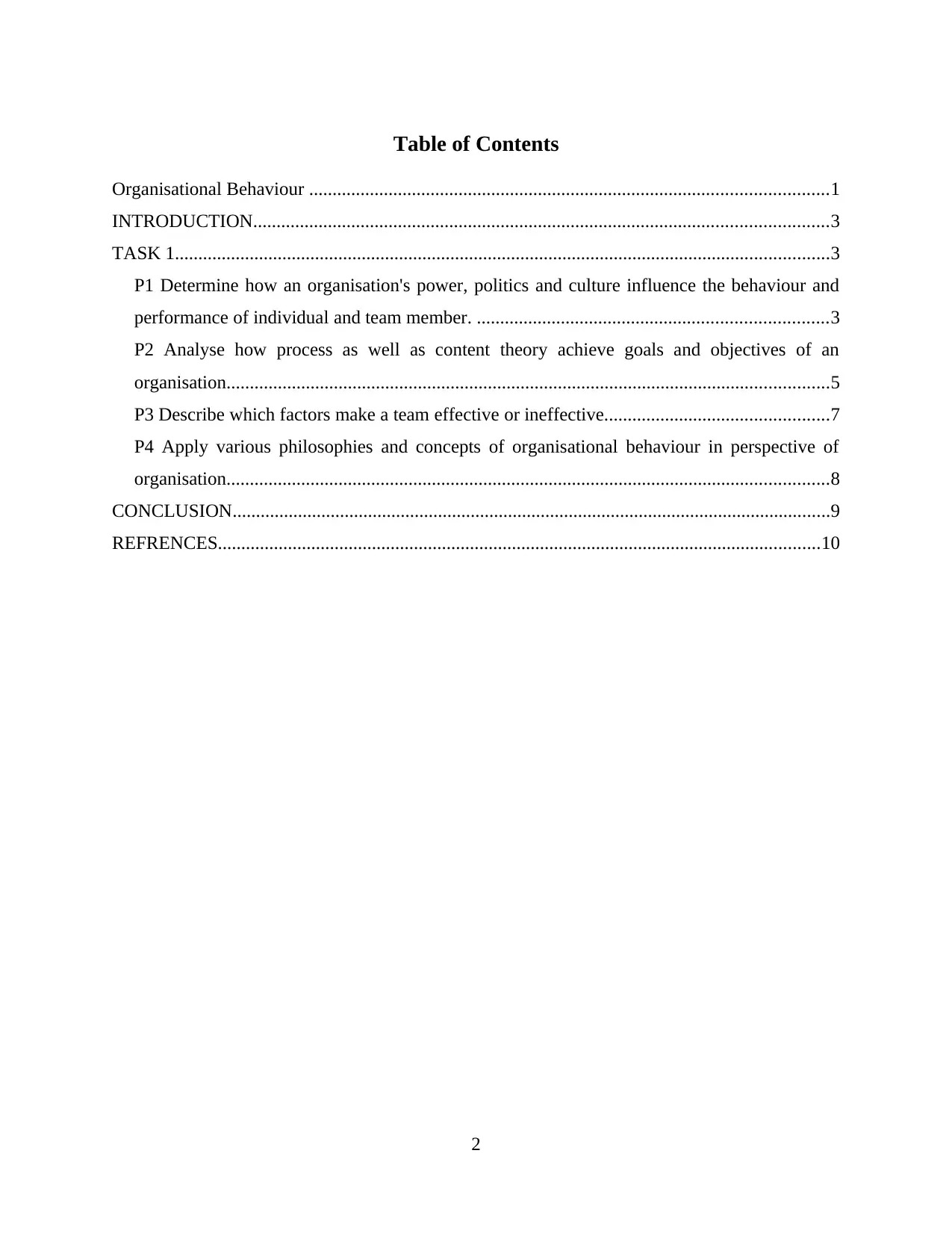
Table of Contents
Organisational Behaviour ...............................................................................................................1
INTRODUCTION...........................................................................................................................3
TASK 1............................................................................................................................................3
P1 Determine how an organisation's power, politics and culture influence the behaviour and
performance of individual and team member. ...........................................................................3
P2 Analyse how process as well as content theory achieve goals and objectives of an
organisation.................................................................................................................................5
P3 Describe which factors make a team effective or ineffective................................................7
P4 Apply various philosophies and concepts of organisational behaviour in perspective of
organisation.................................................................................................................................8
CONCLUSION................................................................................................................................9
REFRENCES.................................................................................................................................10
2
Organisational Behaviour ...............................................................................................................1
INTRODUCTION...........................................................................................................................3
TASK 1............................................................................................................................................3
P1 Determine how an organisation's power, politics and culture influence the behaviour and
performance of individual and team member. ...........................................................................3
P2 Analyse how process as well as content theory achieve goals and objectives of an
organisation.................................................................................................................................5
P3 Describe which factors make a team effective or ineffective................................................7
P4 Apply various philosophies and concepts of organisational behaviour in perspective of
organisation.................................................................................................................................8
CONCLUSION................................................................................................................................9
REFRENCES.................................................................................................................................10
2
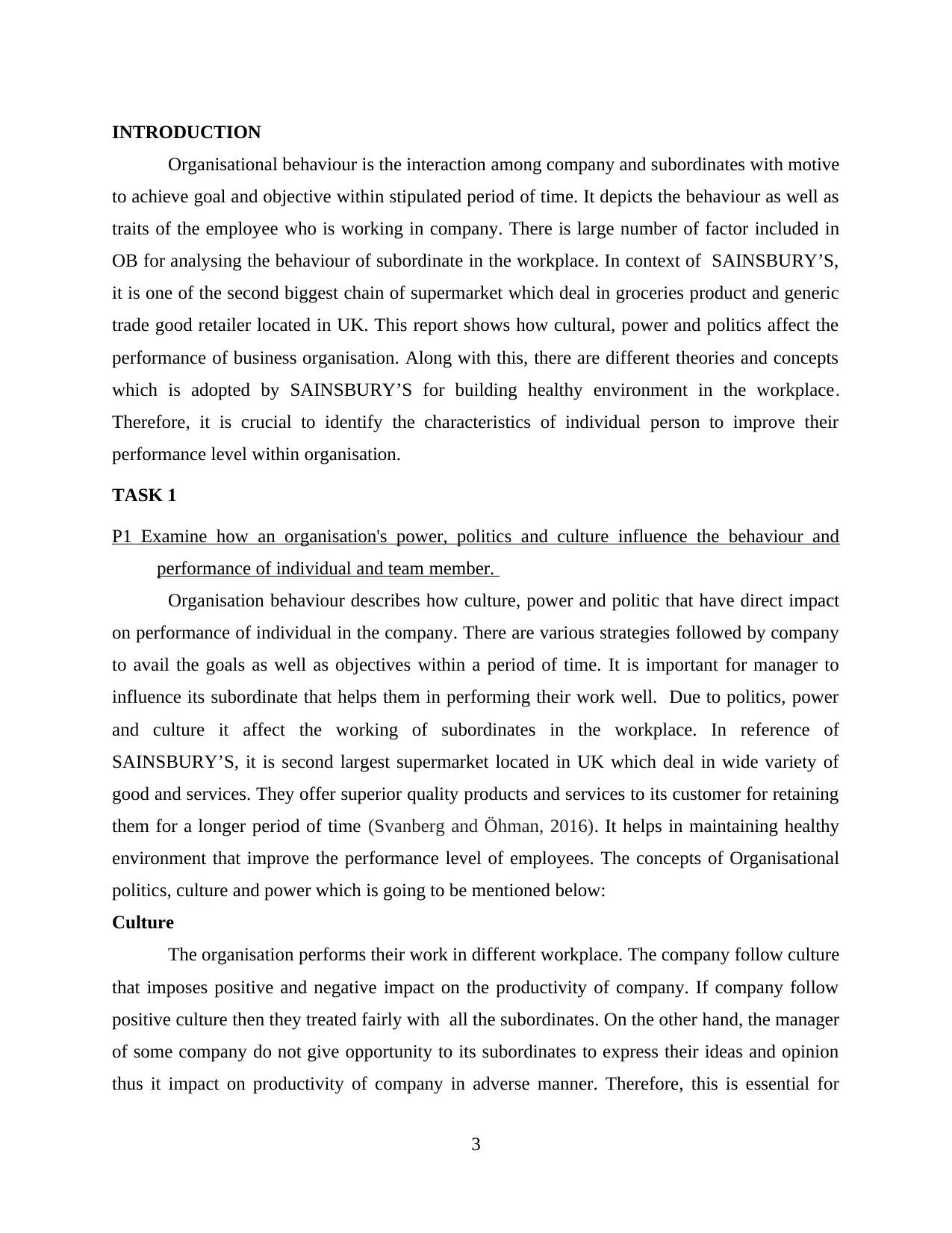
INTRODUCTION
Organisational behaviour is the interaction among company and subordinates with motive
to achieve goal and objective within stipulated period of time. It depicts the behaviour as well as
traits of the employee who is working in company. There is large number of factor included in
OB for analysing the behaviour of subordinate in the workplace. In context of SAINSBURY’S,
it is one of the second biggest chain of supermarket which deal in groceries product and generic
trade good retailer located in UK. This report shows how cultural, power and politics affect the
performance of business organisation. Along with this, there are different theories and concepts
which is adopted by SAINSBURY’S for building healthy environment in the workplace.
Therefore, it is crucial to identify the characteristics of individual person to improve their
performance level within organisation.
TASK 1
P1 Examine how an organisation's power, politics and culture influence the behaviour and
performance of individual and team member.
Organisation behaviour describes how culture, power and politic that have direct impact
on performance of individual in the company. There are various strategies followed by company
to avail the goals as well as objectives within a period of time. It is important for manager to
influence its subordinate that helps them in performing their work well. Due to politics, power
and culture it affect the working of subordinates in the workplace. In reference of
SAINSBURY’S, it is second largest supermarket located in UK which deal in wide variety of
good and services. They offer superior quality products and services to its customer for retaining
them for a longer period of time (Svanberg and Öhman, 2016). It helps in maintaining healthy
environment that improve the performance level of employees. The concepts of Organisational
politics, culture and power which is going to be mentioned below:
Culture
The organisation performs their work in different workplace. The company follow culture
that imposes positive and negative impact on the productivity of company. If company follow
positive culture then they treated fairly with all the subordinates. On the other hand, the manager
of some company do not give opportunity to its subordinates to express their ideas and opinion
thus it impact on productivity of company in adverse manner. Therefore, this is essential for
3
Organisational behaviour is the interaction among company and subordinates with motive
to achieve goal and objective within stipulated period of time. It depicts the behaviour as well as
traits of the employee who is working in company. There is large number of factor included in
OB for analysing the behaviour of subordinate in the workplace. In context of SAINSBURY’S,
it is one of the second biggest chain of supermarket which deal in groceries product and generic
trade good retailer located in UK. This report shows how cultural, power and politics affect the
performance of business organisation. Along with this, there are different theories and concepts
which is adopted by SAINSBURY’S for building healthy environment in the workplace.
Therefore, it is crucial to identify the characteristics of individual person to improve their
performance level within organisation.
TASK 1
P1 Examine how an organisation's power, politics and culture influence the behaviour and
performance of individual and team member.
Organisation behaviour describes how culture, power and politic that have direct impact
on performance of individual in the company. There are various strategies followed by company
to avail the goals as well as objectives within a period of time. It is important for manager to
influence its subordinate that helps them in performing their work well. Due to politics, power
and culture it affect the working of subordinates in the workplace. In reference of
SAINSBURY’S, it is second largest supermarket located in UK which deal in wide variety of
good and services. They offer superior quality products and services to its customer for retaining
them for a longer period of time (Svanberg and Öhman, 2016). It helps in maintaining healthy
environment that improve the performance level of employees. The concepts of Organisational
politics, culture and power which is going to be mentioned below:
Culture
The organisation performs their work in different workplace. The company follow culture
that imposes positive and negative impact on the productivity of company. If company follow
positive culture then they treated fairly with all the subordinates. On the other hand, the manager
of some company do not give opportunity to its subordinates to express their ideas and opinion
thus it impact on productivity of company in adverse manner. Therefore, this is essential for
3
⊘ This is a preview!⊘
Do you want full access?
Subscribe today to unlock all pages.

Trusted by 1+ million students worldwide
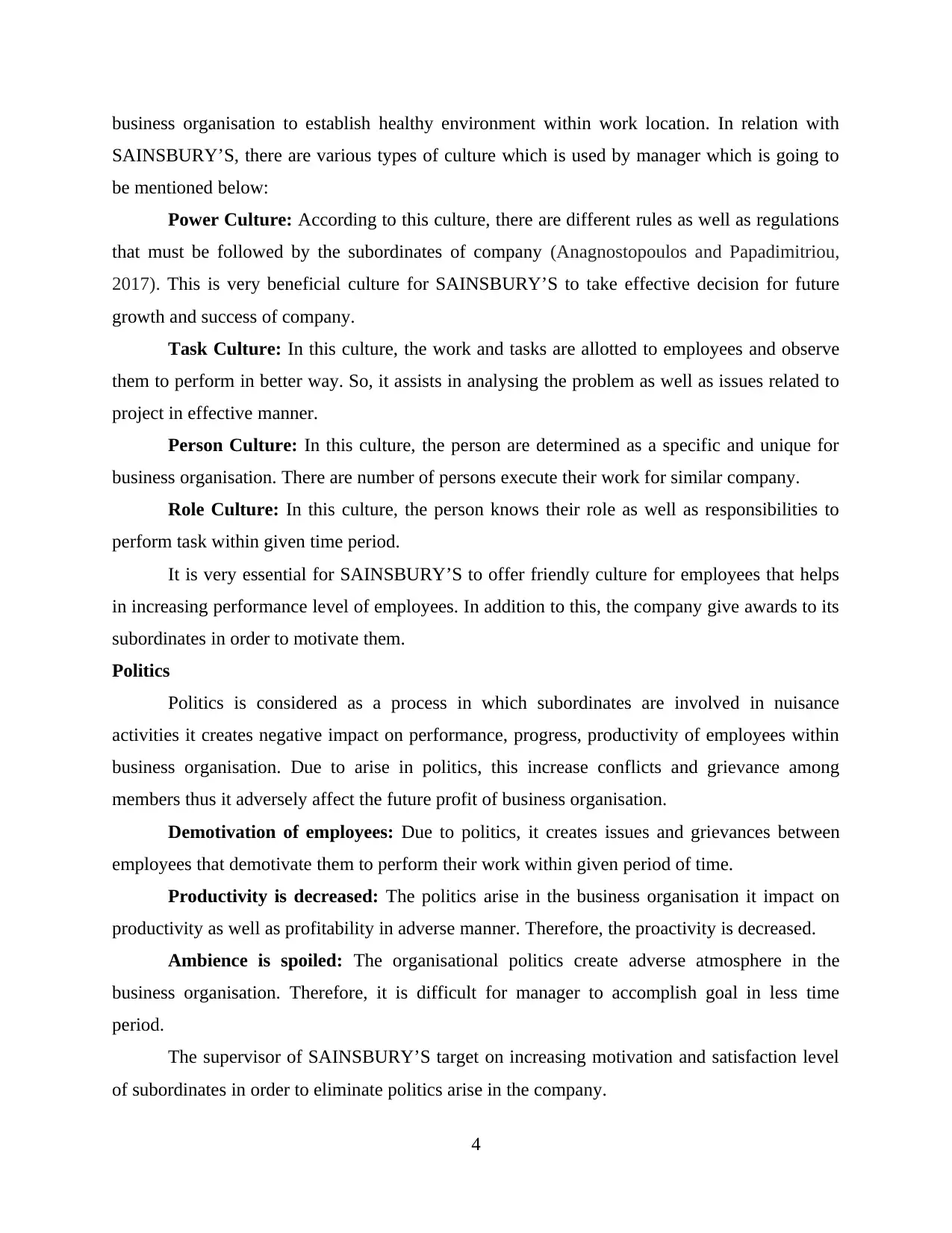
business organisation to establish healthy environment within work location. In relation with
SAINSBURY’S, there are various types of culture which is used by manager which is going to
be mentioned below:
Power Culture: According to this culture, there are different rules as well as regulations
that must be followed by the subordinates of company (Anagnostopoulos and Papadimitriou,
2017). This is very beneficial culture for SAINSBURY’S to take effective decision for future
growth and success of company.
Task Culture: In this culture, the work and tasks are allotted to employees and observe
them to perform in better way. So, it assists in analysing the problem as well as issues related to
project in effective manner.
Person Culture: In this culture, the person are determined as a specific and unique for
business organisation. There are number of persons execute their work for similar company.
Role Culture: In this culture, the person knows their role as well as responsibilities to
perform task within given time period.
It is very essential for SAINSBURY’S to offer friendly culture for employees that helps
in increasing performance level of employees. In addition to this, the company give awards to its
subordinates in order to motivate them.
Politics
Politics is considered as a process in which subordinates are involved in nuisance
activities it creates negative impact on performance, progress, productivity of employees within
business organisation. Due to arise in politics, this increase conflicts and grievance among
members thus it adversely affect the future profit of business organisation.
Demotivation of employees: Due to politics, it creates issues and grievances between
employees that demotivate them to perform their work within given period of time.
Productivity is decreased: The politics arise in the business organisation it impact on
productivity as well as profitability in adverse manner. Therefore, the proactivity is decreased.
Ambience is spoiled: The organisational politics create adverse atmosphere in the
business organisation. Therefore, it is difficult for manager to accomplish goal in less time
period.
The supervisor of SAINSBURY’S target on increasing motivation and satisfaction level
of subordinates in order to eliminate politics arise in the company.
4
SAINSBURY’S, there are various types of culture which is used by manager which is going to
be mentioned below:
Power Culture: According to this culture, there are different rules as well as regulations
that must be followed by the subordinates of company (Anagnostopoulos and Papadimitriou,
2017). This is very beneficial culture for SAINSBURY’S to take effective decision for future
growth and success of company.
Task Culture: In this culture, the work and tasks are allotted to employees and observe
them to perform in better way. So, it assists in analysing the problem as well as issues related to
project in effective manner.
Person Culture: In this culture, the person are determined as a specific and unique for
business organisation. There are number of persons execute their work for similar company.
Role Culture: In this culture, the person knows their role as well as responsibilities to
perform task within given time period.
It is very essential for SAINSBURY’S to offer friendly culture for employees that helps
in increasing performance level of employees. In addition to this, the company give awards to its
subordinates in order to motivate them.
Politics
Politics is considered as a process in which subordinates are involved in nuisance
activities it creates negative impact on performance, progress, productivity of employees within
business organisation. Due to arise in politics, this increase conflicts and grievance among
members thus it adversely affect the future profit of business organisation.
Demotivation of employees: Due to politics, it creates issues and grievances between
employees that demotivate them to perform their work within given period of time.
Productivity is decreased: The politics arise in the business organisation it impact on
productivity as well as profitability in adverse manner. Therefore, the proactivity is decreased.
Ambience is spoiled: The organisational politics create adverse atmosphere in the
business organisation. Therefore, it is difficult for manager to accomplish goal in less time
period.
The supervisor of SAINSBURY’S target on increasing motivation and satisfaction level
of subordinates in order to eliminate politics arise in the company.
4
Paraphrase This Document
Need a fresh take? Get an instant paraphrase of this document with our AI Paraphraser
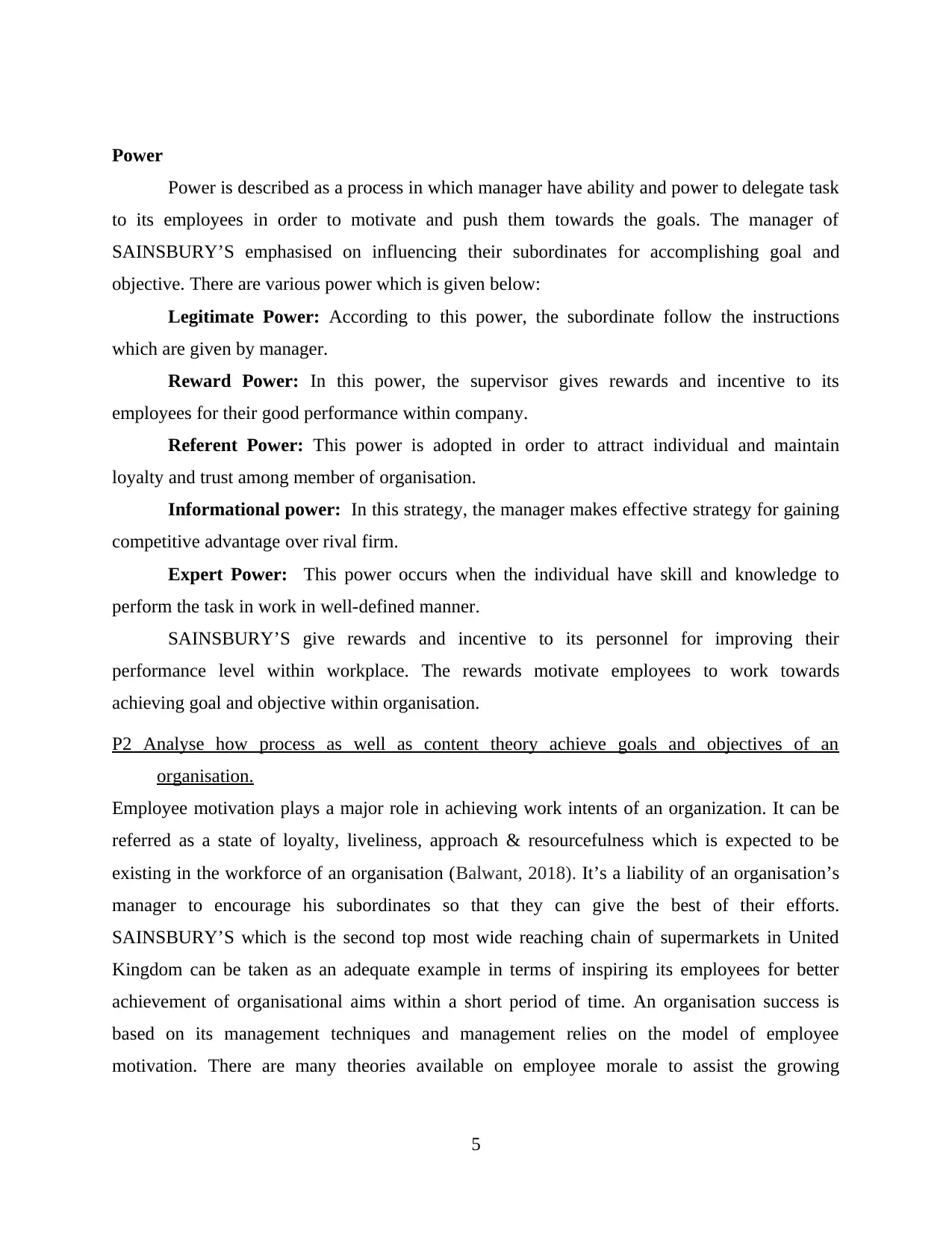
Power
Power is described as a process in which manager have ability and power to delegate task
to its employees in order to motivate and push them towards the goals. The manager of
SAINSBURY’S emphasised on influencing their subordinates for accomplishing goal and
objective. There are various power which is given below:
Legitimate Power: According to this power, the subordinate follow the instructions
which are given by manager.
Reward Power: In this power, the supervisor gives rewards and incentive to its
employees for their good performance within company.
Referent Power: This power is adopted in order to attract individual and maintain
loyalty and trust among member of organisation.
Informational power: In this strategy, the manager makes effective strategy for gaining
competitive advantage over rival firm.
Expert Power: This power occurs when the individual have skill and knowledge to
perform the task in work in well-defined manner.
SAINSBURY’S give rewards and incentive to its personnel for improving their
performance level within workplace. The rewards motivate employees to work towards
achieving goal and objective within organisation.
P2 Analyse how process as well as content theory achieve goals and objectives of an
organisation.
Employee motivation plays a major role in achieving work intents of an organization. It can be
referred as a state of loyalty, liveliness, approach & resourcefulness which is expected to be
existing in the workforce of an organisation (Balwant, 2018). It’s a liability of an organisation’s
manager to encourage his subordinates so that they can give the best of their efforts.
SAINSBURY’S which is the second top most wide reaching chain of supermarkets in United
Kingdom can be taken as an adequate example in terms of inspiring its employees for better
achievement of organisational aims within a short period of time. An organisation success is
based on its management techniques and management relies on the model of employee
motivation. There are many theories available on employee morale to assist the growing
5
Power is described as a process in which manager have ability and power to delegate task
to its employees in order to motivate and push them towards the goals. The manager of
SAINSBURY’S emphasised on influencing their subordinates for accomplishing goal and
objective. There are various power which is given below:
Legitimate Power: According to this power, the subordinate follow the instructions
which are given by manager.
Reward Power: In this power, the supervisor gives rewards and incentive to its
employees for their good performance within company.
Referent Power: This power is adopted in order to attract individual and maintain
loyalty and trust among member of organisation.
Informational power: In this strategy, the manager makes effective strategy for gaining
competitive advantage over rival firm.
Expert Power: This power occurs when the individual have skill and knowledge to
perform the task in work in well-defined manner.
SAINSBURY’S give rewards and incentive to its personnel for improving their
performance level within workplace. The rewards motivate employees to work towards
achieving goal and objective within organisation.
P2 Analyse how process as well as content theory achieve goals and objectives of an
organisation.
Employee motivation plays a major role in achieving work intents of an organization. It can be
referred as a state of loyalty, liveliness, approach & resourcefulness which is expected to be
existing in the workforce of an organisation (Balwant, 2018). It’s a liability of an organisation’s
manager to encourage his subordinates so that they can give the best of their efforts.
SAINSBURY’S which is the second top most wide reaching chain of supermarkets in United
Kingdom can be taken as an adequate example in terms of inspiring its employees for better
achievement of organisational aims within a short period of time. An organisation success is
based on its management techniques and management relies on the model of employee
motivation. There are many theories available on employee morale to assist the growing
5
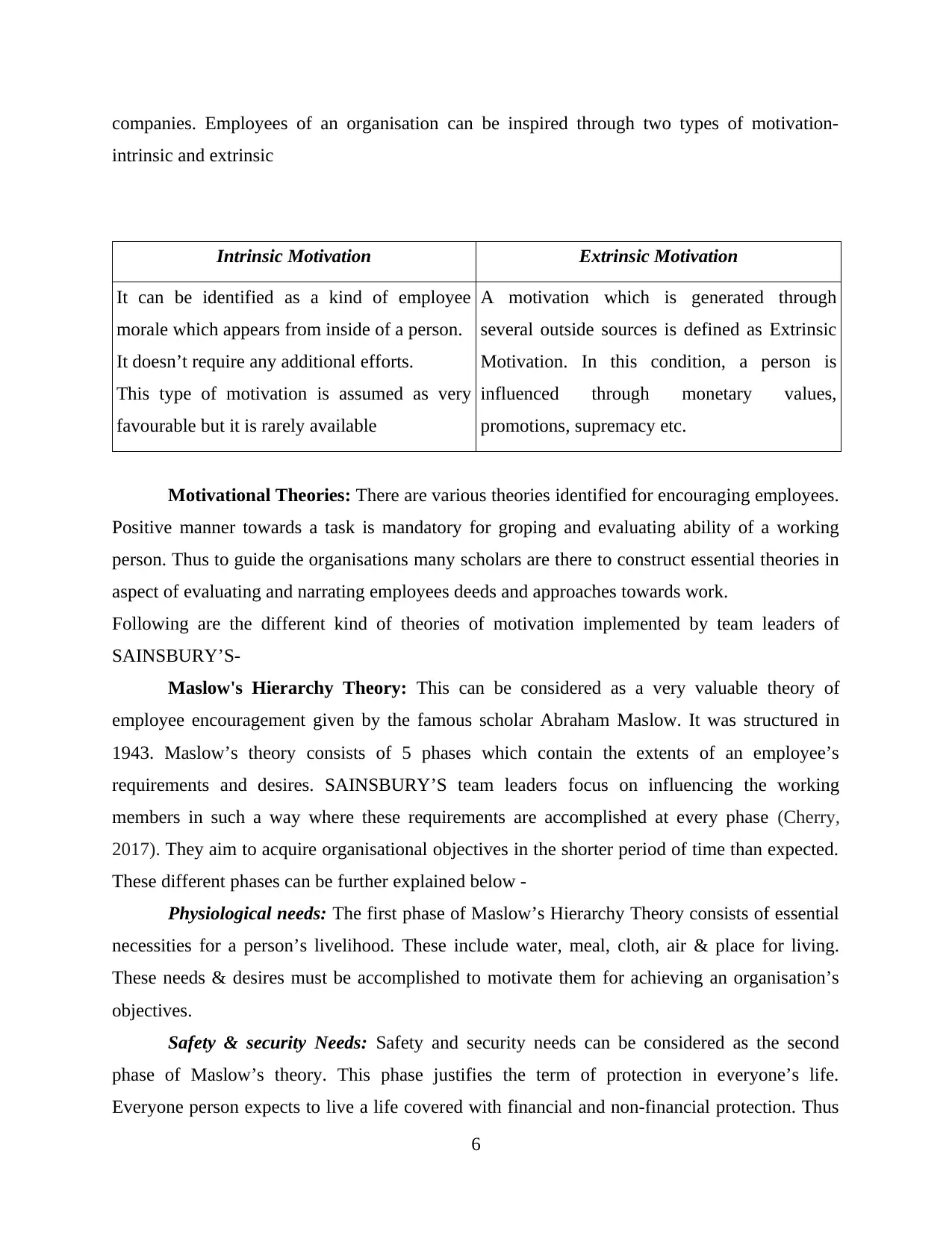
companies. Employees of an organisation can be inspired through two types of motivation-
intrinsic and extrinsic
Intrinsic Motivation Extrinsic Motivation
It can be identified as a kind of employee
morale which appears from inside of a person.
It doesn’t require any additional efforts.
This type of motivation is assumed as very
favourable but it is rarely available
A motivation which is generated through
several outside sources is defined as Extrinsic
Motivation. In this condition, a person is
influenced through monetary values,
promotions, supremacy etc.
Motivational Theories: There are various theories identified for encouraging employees.
Positive manner towards a task is mandatory for groping and evaluating ability of a working
person. Thus to guide the organisations many scholars are there to construct essential theories in
aspect of evaluating and narrating employees deeds and approaches towards work.
Following are the different kind of theories of motivation implemented by team leaders of
SAINSBURY’S-
Maslow's Hierarchy Theory: This can be considered as a very valuable theory of
employee encouragement given by the famous scholar Abraham Maslow. It was structured in
1943. Maslow’s theory consists of 5 phases which contain the extents of an employee’s
requirements and desires. SAINSBURY’S team leaders focus on influencing the working
members in such a way where these requirements are accomplished at every phase (Cherry,
2017). They aim to acquire organisational objectives in the shorter period of time than expected.
These different phases can be further explained below -
Physiological needs: The first phase of Maslow’s Hierarchy Theory consists of essential
necessities for a person’s livelihood. These include water, meal, cloth, air & place for living.
These needs & desires must be accomplished to motivate them for achieving an organisation’s
objectives.
Safety & security Needs: Safety and security needs can be considered as the second
phase of Maslow’s theory. This phase justifies the term of protection in everyone’s life.
Everyone person expects to live a life covered with financial and non-financial protection. Thus
6
intrinsic and extrinsic
Intrinsic Motivation Extrinsic Motivation
It can be identified as a kind of employee
morale which appears from inside of a person.
It doesn’t require any additional efforts.
This type of motivation is assumed as very
favourable but it is rarely available
A motivation which is generated through
several outside sources is defined as Extrinsic
Motivation. In this condition, a person is
influenced through monetary values,
promotions, supremacy etc.
Motivational Theories: There are various theories identified for encouraging employees.
Positive manner towards a task is mandatory for groping and evaluating ability of a working
person. Thus to guide the organisations many scholars are there to construct essential theories in
aspect of evaluating and narrating employees deeds and approaches towards work.
Following are the different kind of theories of motivation implemented by team leaders of
SAINSBURY’S-
Maslow's Hierarchy Theory: This can be considered as a very valuable theory of
employee encouragement given by the famous scholar Abraham Maslow. It was structured in
1943. Maslow’s theory consists of 5 phases which contain the extents of an employee’s
requirements and desires. SAINSBURY’S team leaders focus on influencing the working
members in such a way where these requirements are accomplished at every phase (Cherry,
2017). They aim to acquire organisational objectives in the shorter period of time than expected.
These different phases can be further explained below -
Physiological needs: The first phase of Maslow’s Hierarchy Theory consists of essential
necessities for a person’s livelihood. These include water, meal, cloth, air & place for living.
These needs & desires must be accomplished to motivate them for achieving an organisation’s
objectives.
Safety & security Needs: Safety and security needs can be considered as the second
phase of Maslow’s theory. This phase justifies the term of protection in everyone’s life.
Everyone person expects to live a life covered with financial and non-financial protection. Thus
6
⊘ This is a preview!⊘
Do you want full access?
Subscribe today to unlock all pages.

Trusted by 1+ million students worldwide
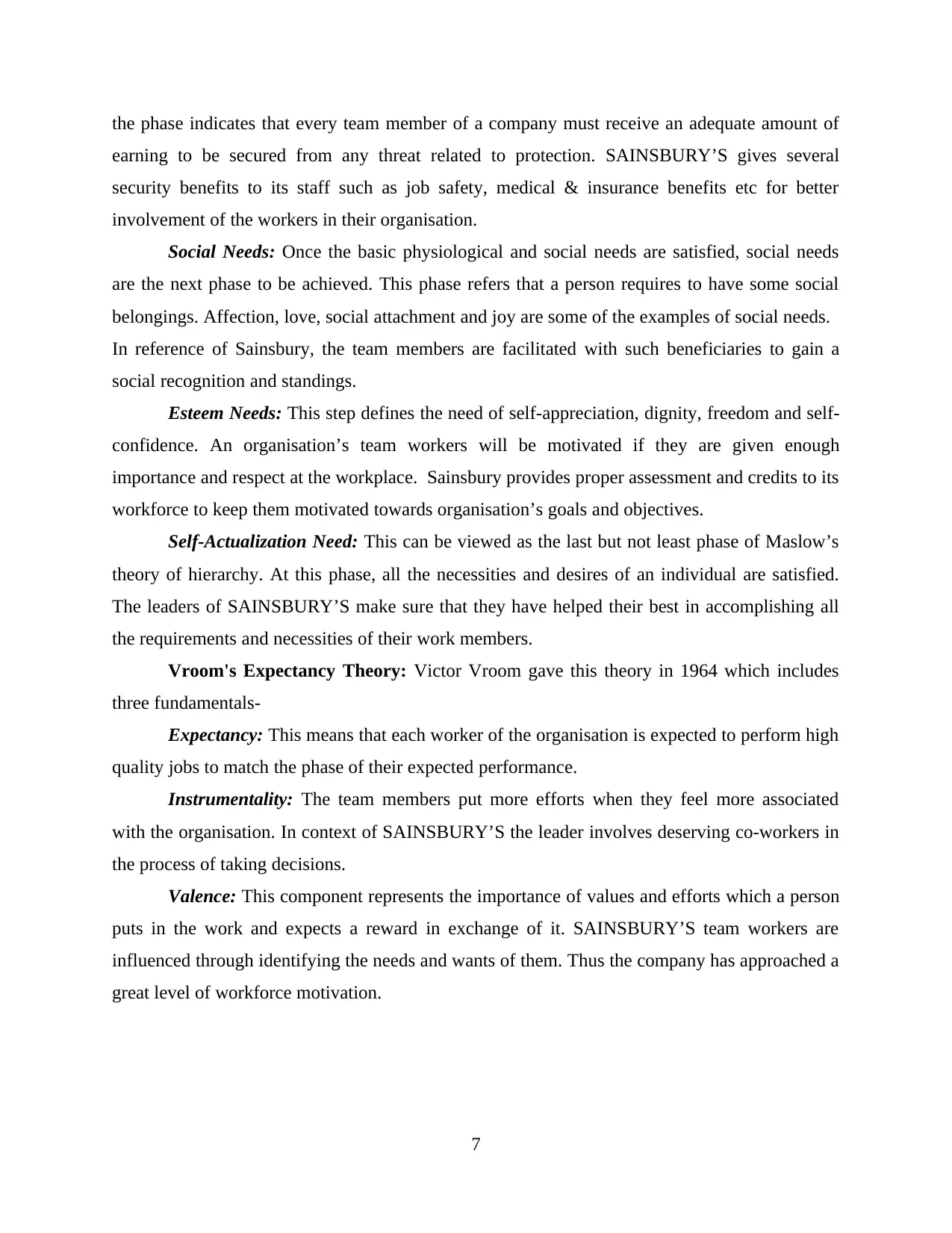
the phase indicates that every team member of a company must receive an adequate amount of
earning to be secured from any threat related to protection. SAINSBURY’S gives several
security benefits to its staff such as job safety, medical & insurance benefits etc for better
involvement of the workers in their organisation.
Social Needs: Once the basic physiological and social needs are satisfied, social needs
are the next phase to be achieved. This phase refers that a person requires to have some social
belongings. Affection, love, social attachment and joy are some of the examples of social needs.
In reference of Sainsbury, the team members are facilitated with such beneficiaries to gain a
social recognition and standings.
Esteem Needs: This step defines the need of self-appreciation, dignity, freedom and self-
confidence. An organisation’s team workers will be motivated if they are given enough
importance and respect at the workplace. Sainsbury provides proper assessment and credits to its
workforce to keep them motivated towards organisation’s goals and objectives.
Self-Actualization Need: This can be viewed as the last but not least phase of Maslow’s
theory of hierarchy. At this phase, all the necessities and desires of an individual are satisfied.
The leaders of SAINSBURY’S make sure that they have helped their best in accomplishing all
the requirements and necessities of their work members.
Vroom's Expectancy Theory: Victor Vroom gave this theory in 1964 which includes
three fundamentals-
Expectancy: This means that each worker of the organisation is expected to perform high
quality jobs to match the phase of their expected performance.
Instrumentality: The team members put more efforts when they feel more associated
with the organisation. In context of SAINSBURY’S the leader involves deserving co-workers in
the process of taking decisions.
Valence: This component represents the importance of values and efforts which a person
puts in the work and expects a reward in exchange of it. SAINSBURY’S team workers are
influenced through identifying the needs and wants of them. Thus the company has approached a
great level of workforce motivation.
7
earning to be secured from any threat related to protection. SAINSBURY’S gives several
security benefits to its staff such as job safety, medical & insurance benefits etc for better
involvement of the workers in their organisation.
Social Needs: Once the basic physiological and social needs are satisfied, social needs
are the next phase to be achieved. This phase refers that a person requires to have some social
belongings. Affection, love, social attachment and joy are some of the examples of social needs.
In reference of Sainsbury, the team members are facilitated with such beneficiaries to gain a
social recognition and standings.
Esteem Needs: This step defines the need of self-appreciation, dignity, freedom and self-
confidence. An organisation’s team workers will be motivated if they are given enough
importance and respect at the workplace. Sainsbury provides proper assessment and credits to its
workforce to keep them motivated towards organisation’s goals and objectives.
Self-Actualization Need: This can be viewed as the last but not least phase of Maslow’s
theory of hierarchy. At this phase, all the necessities and desires of an individual are satisfied.
The leaders of SAINSBURY’S make sure that they have helped their best in accomplishing all
the requirements and necessities of their work members.
Vroom's Expectancy Theory: Victor Vroom gave this theory in 1964 which includes
three fundamentals-
Expectancy: This means that each worker of the organisation is expected to perform high
quality jobs to match the phase of their expected performance.
Instrumentality: The team members put more efforts when they feel more associated
with the organisation. In context of SAINSBURY’S the leader involves deserving co-workers in
the process of taking decisions.
Valence: This component represents the importance of values and efforts which a person
puts in the work and expects a reward in exchange of it. SAINSBURY’S team workers are
influenced through identifying the needs and wants of them. Thus the company has approached a
great level of workforce motivation.
7
Paraphrase This Document
Need a fresh take? Get an instant paraphrase of this document with our AI Paraphraser
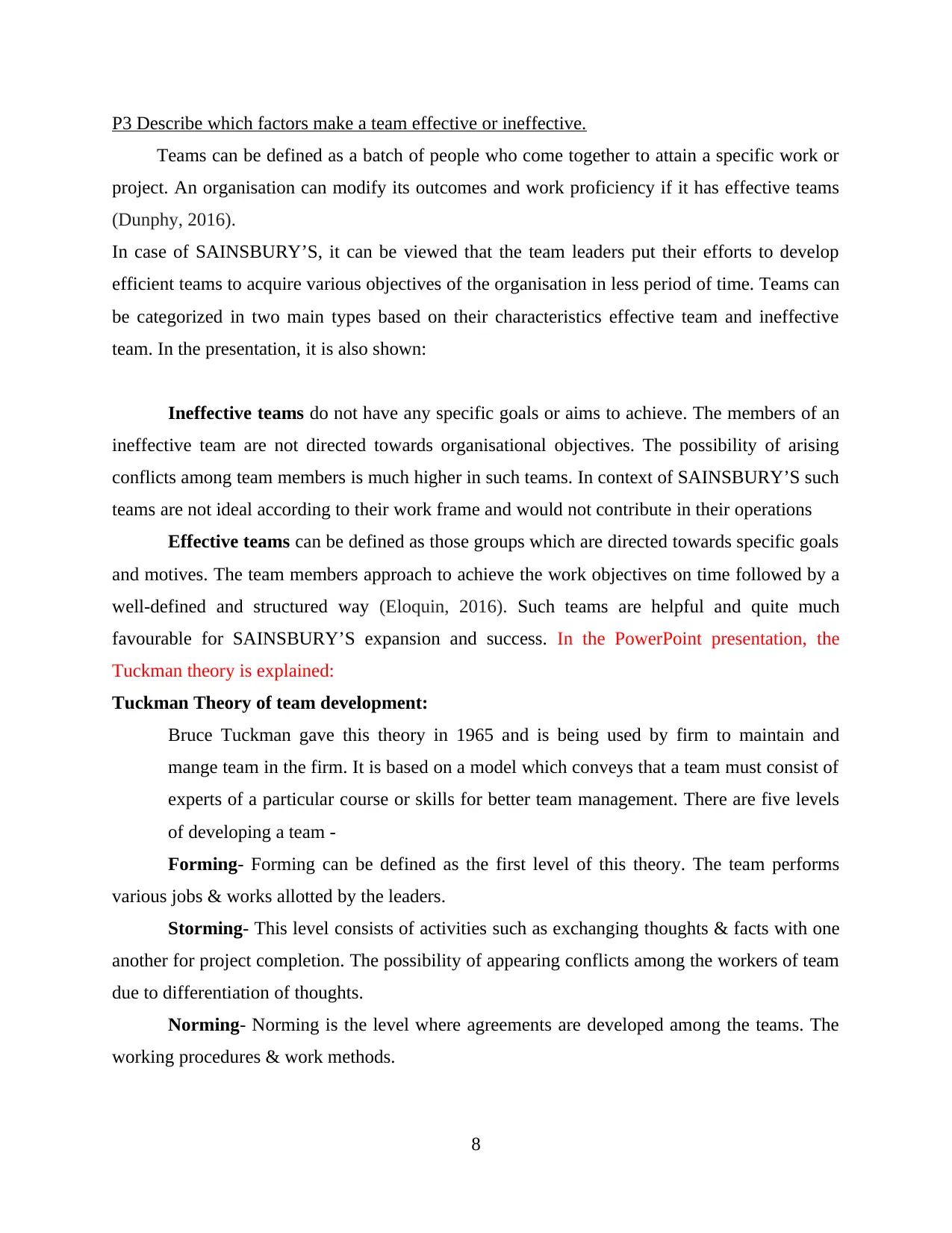
P3 Describe which factors make a team effective or ineffective.
Teams can be defined as a batch of people who come together to attain a specific work or
project. An organisation can modify its outcomes and work proficiency if it has effective teams
(Dunphy, 2016).
In case of SAINSBURY’S, it can be viewed that the team leaders put their efforts to develop
efficient teams to acquire various objectives of the organisation in less period of time. Teams can
be categorized in two main types based on their characteristics effective team and ineffective
team. In the presentation, it is also shown:
Ineffective teams do not have any specific goals or aims to achieve. The members of an
ineffective team are not directed towards organisational objectives. The possibility of arising
conflicts among team members is much higher in such teams. In context of SAINSBURY’S such
teams are not ideal according to their work frame and would not contribute in their operations
Effective teams can be defined as those groups which are directed towards specific goals
and motives. The team members approach to achieve the work objectives on time followed by a
well-defined and structured way (Eloquin, 2016). Such teams are helpful and quite much
favourable for SAINSBURY’S expansion and success. In the PowerPoint presentation, the
Tuckman theory is explained:
Tuckman Theory of team development:
Bruce Tuckman gave this theory in 1965 and is being used by firm to maintain and
mange team in the firm. It is based on a model which conveys that a team must consist of
experts of a particular course or skills for better team management. There are five levels
of developing a team -
Forming- Forming can be defined as the first level of this theory. The team performs
various jobs & works allotted by the leaders.
Storming- This level consists of activities such as exchanging thoughts & facts with one
another for project completion. The possibility of appearing conflicts among the workers of team
due to differentiation of thoughts.
Norming- Norming is the level where agreements are developed among the teams. The
working procedures & work methods.
8
Teams can be defined as a batch of people who come together to attain a specific work or
project. An organisation can modify its outcomes and work proficiency if it has effective teams
(Dunphy, 2016).
In case of SAINSBURY’S, it can be viewed that the team leaders put their efforts to develop
efficient teams to acquire various objectives of the organisation in less period of time. Teams can
be categorized in two main types based on their characteristics effective team and ineffective
team. In the presentation, it is also shown:
Ineffective teams do not have any specific goals or aims to achieve. The members of an
ineffective team are not directed towards organisational objectives. The possibility of arising
conflicts among team members is much higher in such teams. In context of SAINSBURY’S such
teams are not ideal according to their work frame and would not contribute in their operations
Effective teams can be defined as those groups which are directed towards specific goals
and motives. The team members approach to achieve the work objectives on time followed by a
well-defined and structured way (Eloquin, 2016). Such teams are helpful and quite much
favourable for SAINSBURY’S expansion and success. In the PowerPoint presentation, the
Tuckman theory is explained:
Tuckman Theory of team development:
Bruce Tuckman gave this theory in 1965 and is being used by firm to maintain and
mange team in the firm. It is based on a model which conveys that a team must consist of
experts of a particular course or skills for better team management. There are five levels
of developing a team -
Forming- Forming can be defined as the first level of this theory. The team performs
various jobs & works allotted by the leaders.
Storming- This level consists of activities such as exchanging thoughts & facts with one
another for project completion. The possibility of appearing conflicts among the workers of team
due to differentiation of thoughts.
Norming- Norming is the level where agreements are developed among the teams. The
working procedures & work methods.
8
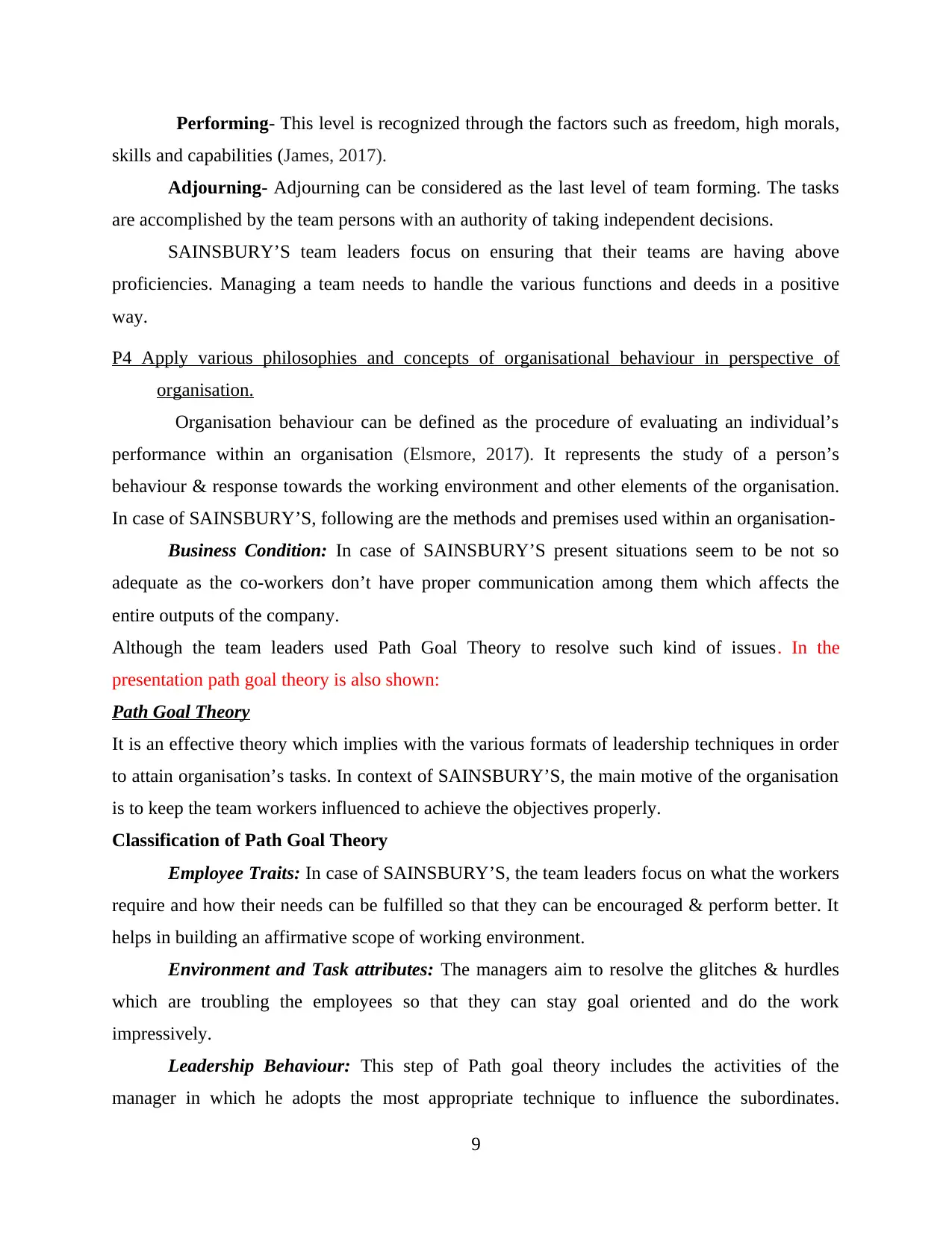
Performing- This level is recognized through the factors such as freedom, high morals,
skills and capabilities (James, 2017).
Adjourning- Adjourning can be considered as the last level of team forming. The tasks
are accomplished by the team persons with an authority of taking independent decisions.
SAINSBURY’S team leaders focus on ensuring that their teams are having above
proficiencies. Managing a team needs to handle the various functions and deeds in a positive
way.
P4 Apply various philosophies and concepts of organisational behaviour in perspective of
organisation.
Organisation behaviour can be defined as the procedure of evaluating an individual’s
performance within an organisation (Elsmore, 2017). It represents the study of a person’s
behaviour & response towards the working environment and other elements of the organisation.
In case of SAINSBURY’S, following are the methods and premises used within an organisation-
Business Condition: In case of SAINSBURY’S present situations seem to be not so
adequate as the co-workers don’t have proper communication among them which affects the
entire outputs of the company.
Although the team leaders used Path Goal Theory to resolve such kind of issues. In the
presentation path goal theory is also shown:
Path Goal Theory
It is an effective theory which implies with the various formats of leadership techniques in order
to attain organisation’s tasks. In context of SAINSBURY’S, the main motive of the organisation
is to keep the team workers influenced to achieve the objectives properly.
Classification of Path Goal Theory
Employee Traits: In case of SAINSBURY’S, the team leaders focus on what the workers
require and how their needs can be fulfilled so that they can be encouraged & perform better. It
helps in building an affirmative scope of working environment.
Environment and Task attributes: The managers aim to resolve the glitches & hurdles
which are troubling the employees so that they can stay goal oriented and do the work
impressively.
Leadership Behaviour: This step of Path goal theory includes the activities of the
manager in which he adopts the most appropriate technique to influence the subordinates.
9
skills and capabilities (James, 2017).
Adjourning- Adjourning can be considered as the last level of team forming. The tasks
are accomplished by the team persons with an authority of taking independent decisions.
SAINSBURY’S team leaders focus on ensuring that their teams are having above
proficiencies. Managing a team needs to handle the various functions and deeds in a positive
way.
P4 Apply various philosophies and concepts of organisational behaviour in perspective of
organisation.
Organisation behaviour can be defined as the procedure of evaluating an individual’s
performance within an organisation (Elsmore, 2017). It represents the study of a person’s
behaviour & response towards the working environment and other elements of the organisation.
In case of SAINSBURY’S, following are the methods and premises used within an organisation-
Business Condition: In case of SAINSBURY’S present situations seem to be not so
adequate as the co-workers don’t have proper communication among them which affects the
entire outputs of the company.
Although the team leaders used Path Goal Theory to resolve such kind of issues. In the
presentation path goal theory is also shown:
Path Goal Theory
It is an effective theory which implies with the various formats of leadership techniques in order
to attain organisation’s tasks. In context of SAINSBURY’S, the main motive of the organisation
is to keep the team workers influenced to achieve the objectives properly.
Classification of Path Goal Theory
Employee Traits: In case of SAINSBURY’S, the team leaders focus on what the workers
require and how their needs can be fulfilled so that they can be encouraged & perform better. It
helps in building an affirmative scope of working environment.
Environment and Task attributes: The managers aim to resolve the glitches & hurdles
which are troubling the employees so that they can stay goal oriented and do the work
impressively.
Leadership Behaviour: This step of Path goal theory includes the activities of the
manager in which he adopts the most appropriate technique to influence the subordinates.
9
⊘ This is a preview!⊘
Do you want full access?
Subscribe today to unlock all pages.

Trusted by 1+ million students worldwide
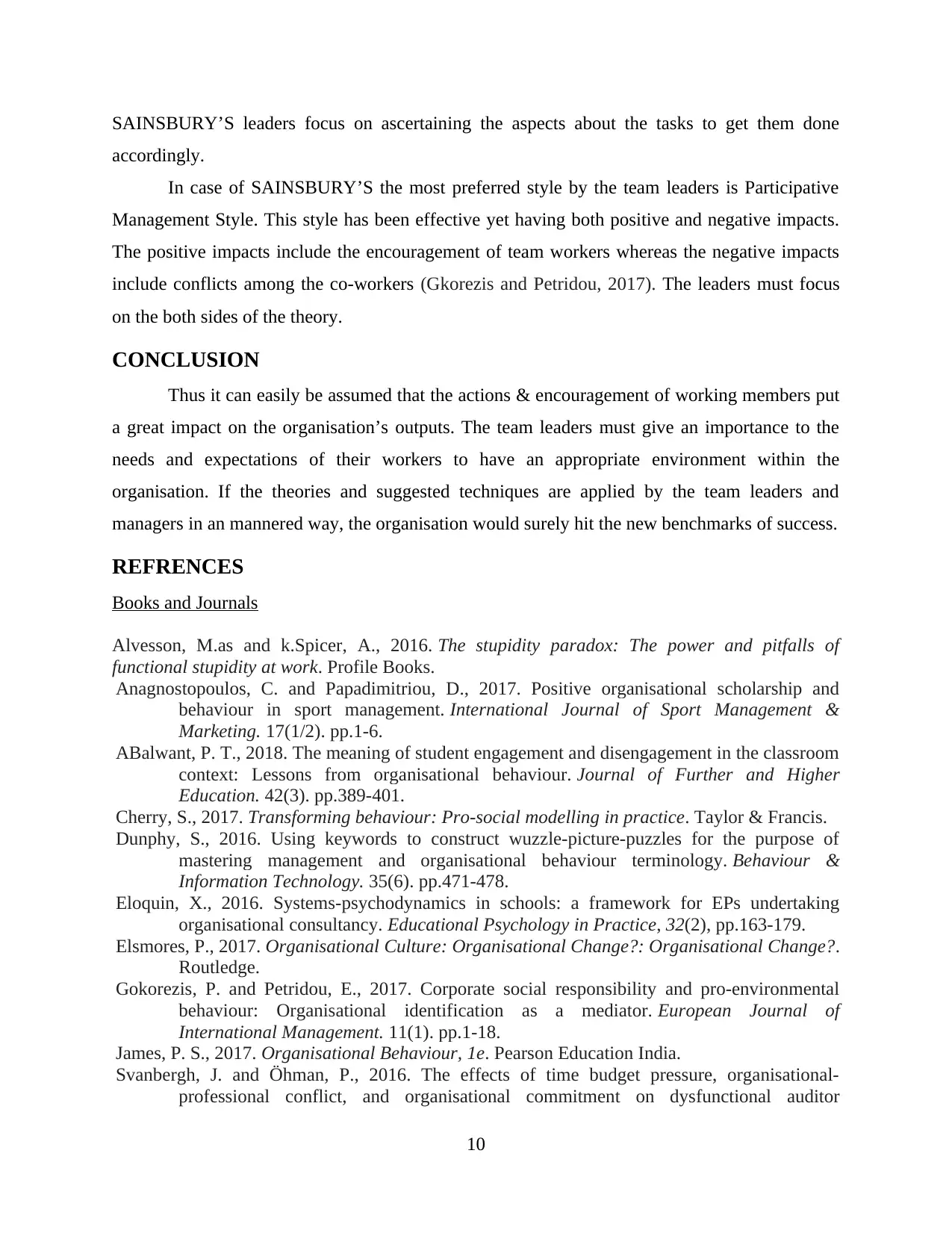
SAINSBURY’S leaders focus on ascertaining the aspects about the tasks to get them done
accordingly.
In case of SAINSBURY’S the most preferred style by the team leaders is Participative
Management Style. This style has been effective yet having both positive and negative impacts.
The positive impacts include the encouragement of team workers whereas the negative impacts
include conflicts among the co-workers (Gkorezis and Petridou, 2017). The leaders must focus
on the both sides of the theory.
CONCLUSION
Thus it can easily be assumed that the actions & encouragement of working members put
a great impact on the organisation’s outputs. The team leaders must give an importance to the
needs and expectations of their workers to have an appropriate environment within the
organisation. If the theories and suggested techniques are applied by the team leaders and
managers in an mannered way, the organisation would surely hit the new benchmarks of success.
REFRENCES
Books and Journals
Alvesson, M.as and k.Spicer, A., 2016. The stupidity paradox: The power and pitfalls of
functional stupidity at work. Profile Books.
Anagnostopoulos, C. and Papadimitriou, D., 2017. Positive organisational scholarship and
behaviour in sport management. International Journal of Sport Management &
Marketing. 17(1/2). pp.1-6.
ABalwant, P. T., 2018. The meaning of student engagement and disengagement in the classroom
context: Lessons from organisational behaviour. Journal of Further and Higher
Education. 42(3). pp.389-401.
Cherry, S., 2017. Transforming behaviour: Pro-social modelling in practice. Taylor & Francis.
Dunphy, S., 2016. Using keywords to construct wuzzle-picture-puzzles for the purpose of
mastering management and organisational behaviour terminology. Behaviour &
Information Technology. 35(6). pp.471-478.
Eloquin, X., 2016. Systems-psychodynamics in schools: a framework for EPs undertaking
organisational consultancy. Educational Psychology in Practice, 32(2), pp.163-179.
Elsmores, P., 2017. Organisational Culture: Organisational Change?: Organisational Change?.
Routledge.
Gokorezis, P. and Petridou, E., 2017. Corporate social responsibility and pro-environmental
behaviour: Organisational identification as a mediator. European Journal of
International Management. 11(1). pp.1-18.
James, P. S., 2017. Organisational Behaviour, 1e. Pearson Education India.
Svanbergh, J. and Öhman, P., 2016. The effects of time budget pressure, organisational-
professional conflict, and organisational commitment on dysfunctional auditor
10
accordingly.
In case of SAINSBURY’S the most preferred style by the team leaders is Participative
Management Style. This style has been effective yet having both positive and negative impacts.
The positive impacts include the encouragement of team workers whereas the negative impacts
include conflicts among the co-workers (Gkorezis and Petridou, 2017). The leaders must focus
on the both sides of the theory.
CONCLUSION
Thus it can easily be assumed that the actions & encouragement of working members put
a great impact on the organisation’s outputs. The team leaders must give an importance to the
needs and expectations of their workers to have an appropriate environment within the
organisation. If the theories and suggested techniques are applied by the team leaders and
managers in an mannered way, the organisation would surely hit the new benchmarks of success.
REFRENCES
Books and Journals
Alvesson, M.as and k.Spicer, A., 2016. The stupidity paradox: The power and pitfalls of
functional stupidity at work. Profile Books.
Anagnostopoulos, C. and Papadimitriou, D., 2017. Positive organisational scholarship and
behaviour in sport management. International Journal of Sport Management &
Marketing. 17(1/2). pp.1-6.
ABalwant, P. T., 2018. The meaning of student engagement and disengagement in the classroom
context: Lessons from organisational behaviour. Journal of Further and Higher
Education. 42(3). pp.389-401.
Cherry, S., 2017. Transforming behaviour: Pro-social modelling in practice. Taylor & Francis.
Dunphy, S., 2016. Using keywords to construct wuzzle-picture-puzzles for the purpose of
mastering management and organisational behaviour terminology. Behaviour &
Information Technology. 35(6). pp.471-478.
Eloquin, X., 2016. Systems-psychodynamics in schools: a framework for EPs undertaking
organisational consultancy. Educational Psychology in Practice, 32(2), pp.163-179.
Elsmores, P., 2017. Organisational Culture: Organisational Change?: Organisational Change?.
Routledge.
Gokorezis, P. and Petridou, E., 2017. Corporate social responsibility and pro-environmental
behaviour: Organisational identification as a mediator. European Journal of
International Management. 11(1). pp.1-18.
James, P. S., 2017. Organisational Behaviour, 1e. Pearson Education India.
Svanbergh, J. and Öhman, P., 2016. The effects of time budget pressure, organisational-
professional conflict, and organisational commitment on dysfunctional auditor
10
Paraphrase This Document
Need a fresh take? Get an instant paraphrase of this document with our AI Paraphraser
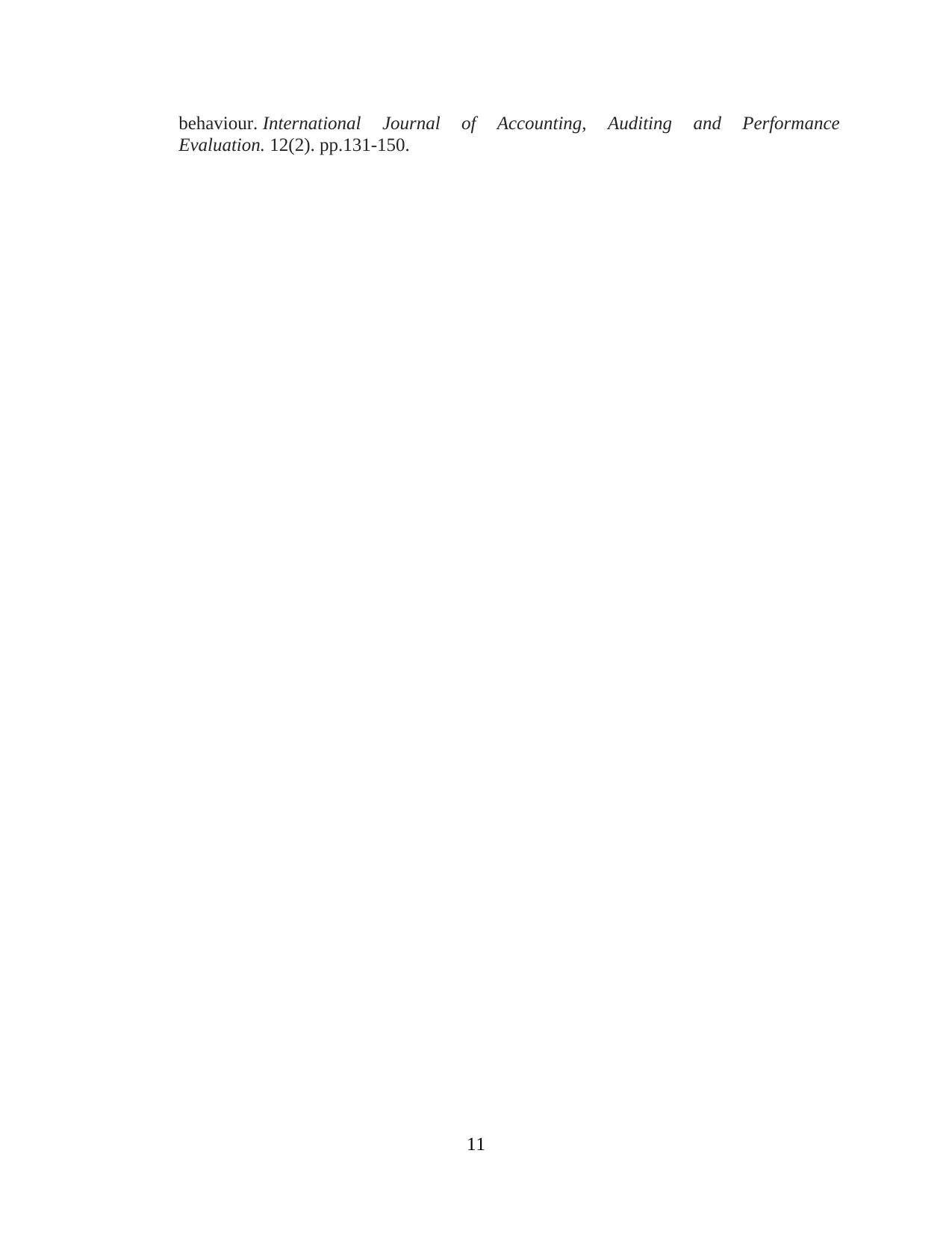
behaviour. International Journal of Accounting, Auditing and Performance
Evaluation. 12(2). pp.131-150.
11
Evaluation. 12(2). pp.131-150.
11
1 out of 11
Related Documents
Your All-in-One AI-Powered Toolkit for Academic Success.
+13062052269
info@desklib.com
Available 24*7 on WhatsApp / Email
![[object Object]](/_next/static/media/star-bottom.7253800d.svg)
Unlock your academic potential
Copyright © 2020–2025 A2Z Services. All Rights Reserved. Developed and managed by ZUCOL.





